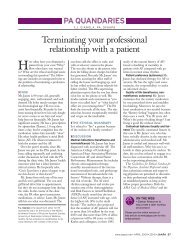Essential Guide to E-mail Marketing - Haymarket
Essential Guide to E-mail Marketing - Haymarket
Essential Guide to E-mail Marketing - Haymarket
You also want an ePaper? Increase the reach of your titles
YUMPU automatically turns print PDFs into web optimized ePapers that Google loves.
18 FUNDAMENTALS DM News • E-Mail <strong>Marketing</strong> <strong>Guide</strong> 2007<br />
ones, including unsubscribes and spam complaints.<br />
Check your <strong>mail</strong>ing list for a pulse. Chances are, half your <strong>mail</strong>ing<br />
list is inactive. Determine how many addresses have not responded<br />
for a set amount of time, say six months. Send a message <strong>to</strong> those<br />
addresses, inviting them <strong>to</strong> opt in again, update their preferences or<br />
take advantage of a special offer. Those who don’t respond can be<br />
safely deleted.<br />
Dave Dabbah is vice president of marketing at Lyris Technologies. He can be<br />
reached at ddabbah@lyris.com.<br />
So you want <strong>to</strong> reach<br />
the inbox?<br />
BY JARED REITZIN<br />
In the constantly changing world of e-<strong>mail</strong> marketing, reaching<br />
the inbox has become a lot more complicated than just pressing<br />
“send.” For most marketers, sending successful e-<strong>mail</strong> campaigns<br />
has become a tedious process with numerous hoops <strong>to</strong> jump<br />
through. The continuing prevalence of spam has led <strong>to</strong> more and<br />
more “false positives,” or legitimate e-<strong>mail</strong> messages that get incorrectly<br />
labeled as spam and therefore never reach their intended<br />
audience. According <strong>to</strong> Return Path, an e-<strong>mail</strong> performance solutions<br />
company, more than 20 percent of permission-based e-<strong>mail</strong>s<br />
go undelivered. This accounts for<br />
billions of dollars in lost revenue.<br />
The rules keep changing and<br />
marketers need <strong>to</strong> adapt, or it’s<br />
going <strong>to</strong> hurt their pocket books.<br />
There have been big changes in<br />
how ISPs identify spam. In the<br />
past, spam filters would determine<br />
whether a message was<br />
legitimate based on its content.<br />
The more suspicious the content,<br />
the higher the potential for a<br />
Jared Reitzin<br />
spam score. However, the ISPs<br />
MobileS<strong>to</strong>rm<br />
soon realized that technique was<br />
insufficient, so they now take a more comprehensive approach,<br />
analyzing the sending IP address and the sender itself. This has<br />
given rise <strong>to</strong> the concept of sender reputation.<br />
So what exactly is sender reputation? It goes beyond a mere<br />
message check or spam filtering <strong>to</strong> investigate your overall status<br />
as a sender. Below are the four most important things you need <strong>to</strong><br />
take care of if you want <strong>to</strong> be a reputable e-<strong>mail</strong> marketer:<br />
Complaints Complaints logged against your campaigns are a key<br />
component <strong>to</strong> your sender reputation. Sending e-<strong>mail</strong>s <strong>to</strong>o often,<br />
or sending messages with irrelevant content and adding people<br />
without their knowledge, are a few ways <strong>to</strong> get in trouble. Avoid<br />
complaints by practicing permission, setting expectations and<br />
understanding your audience.<br />
List Cleansing It is important <strong>to</strong> have a list that has been built<br />
naturally and with the subscribers’ permission. It needs <strong>to</strong> be<br />
maintained and scrubbed for invalid e-<strong>mail</strong> addresses, dead e-<strong>mail</strong><br />
addresses and, most important, unsubscribe requests and complaints.<br />
Consistent List/Brand Matching A common mistake by e-<strong>mail</strong><br />
marketers is <strong>to</strong> assume that because you have captured an e-<strong>mail</strong><br />
ESSENTIAL GUIDE<br />
address for one brand, you have permission <strong>to</strong> e-<strong>mail</strong> them about<br />
another. You earn your reputation by keeping every brand separate<br />
and distinct from each other. Include this policy in your privacy<br />
agreements.<br />
Relevant Messages The days of “batch and blast” are long gone.<br />
Nowadays, it is all about making sure your intended recipients<br />
find the campaign relevant. If you are a pet supply s<strong>to</strong>re, don’t<br />
send dog food offers <strong>to</strong> parakeet owners. A solid e-<strong>mail</strong> marketing<br />
platform that allows you <strong>to</strong> create targets will go a long way for<br />
your reputation.<br />
Inbox delivery is a complex and organic process, so you must be<br />
vigilant about ensuring you know the rules and follow them both<br />
<strong>to</strong>day and as they continue <strong>to</strong> evolve.<br />
Jared Reitzin is CEO and founder of mobileS<strong>to</strong>rm. He can be reached at<br />
jared@mobiles<strong>to</strong>rm.com.<br />
Build your house list the<br />
right way<br />
BY JERE DOYLE<br />
It’s no secret that the key <strong>to</strong> building a successful brand is <strong>to</strong><br />
build solid relationships with your cus<strong>to</strong>mers. Building and corresponding<br />
with your in-house list can be one of the most effective<br />
marketing tactics there is.<br />
What is surprising, however, is that many brand marketers are<br />
using (sometimes unknowingly) poor practices in building their inhouse<br />
e-<strong>mail</strong> list via online cus<strong>to</strong>mer acquisition. These bad practices<br />
often include the selling or sharing of consumer data <strong>to</strong> third<br />
parties, irresponsible use of e-<strong>mail</strong> (such as bombarding consumers<br />
with <strong>to</strong>o many messages) and forced registration.<br />
Initially, some companies may see a quick surge in profits by following<br />
these irresponsible practices, but they will ultimately feel<br />
negative effects on profits as lead quality suffers. Poor lead quality<br />
results in poor ROI and will ultimately harm a brand’s reputation<br />
as consumer trust is lost. The practices mentioned above also<br />
reflect poorly on the lead generation industry as a whole, which is<br />
why leaders in this industry need <strong>to</strong> be more vocal when breaches<br />
occur.<br />
Not only are unethical e-<strong>mail</strong> practices harmful for brands, they<br />
are a direct violation of consumer<br />
privacy and trust. Once a consumer’s<br />
online experience has<br />
been tainted, he is more likely <strong>to</strong><br />
think twice about shopping, participating<br />
in communities or sharing<br />
his personal information on<br />
the Web. Consumers are savvy,<br />
and if they feel violated they will<br />
turn <strong>to</strong> a new source for the<br />
information they need. It then<br />
becomes very difficult, and often<br />
Jere Doyle<br />
impossible, <strong>to</strong> regain their trust.<br />
Prospectiv<br />
This is why it’s imperative <strong>to</strong><br />
follow best practices that build trust among your cus<strong>to</strong>mers and<br />
promote high standards within the industry:<br />
■ Allow consumers <strong>to</strong> opt in for each offer. Let them choose what<br />
information and promotions they would like <strong>to</strong> receive one at a
















